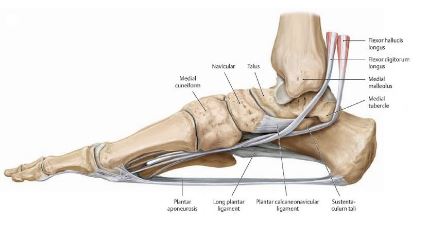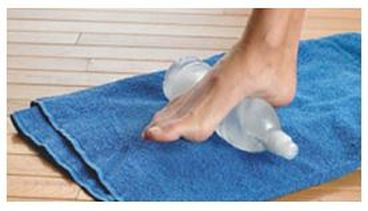 Are you experiencing sore or painful arches? Is it altering the way you walk and perform your everyday activities? It is an affliction that affects many people of different foot types and can come about from a range of activities from everyday walking to strenuous exercise. As a podiatrist, next to heel pain, arch pain is one of the most commonly occurring problems that patients present with to the clinic. Often times patients cannot recall one single incident that triggered off the symptoms but describe it as having a slow and insidious onset. Some complain that the pain is bad enough to become debilitating whilst others report that it is more ‘annoying than anything else’ So in saying that, let's explore exactly what the arches of the feet consist of and why their structures are prone to damage. Having a look at the image to the right, it is easy to appreciate how complex the arch of the foot is. In reality the structure is actually made up of an interplay of bones, ligaments, muscle tendons and tough fibrous structures. All of these pieces fit together in a puzzle that create a structure that works tirelessly to evenly distribute the forces of the body weight during our everyday activities. It is also easy to see how pain can develop from overuse of these structures. The structures most commonly associated with arch pain include the plantar fascia, plantar ligaments and the flexor digitorum/hallucis longus tendons. Whilst many factors may be contributing factors to the development of arch pain, the common culprits include some of the following:
Since most of the structures we are dealing with in the arch region of the foot are ‘soft tissues’ any injury to the area would result in an inflammatory response by the body. What this means is, an injury would often result in pain, warmth and swelling. Thus, for cases of arch pain that present to me, the first line of treatment would focus on reducing and alleviating the discomfort caused.. Apply ice to the affected region daily for 10 minutes. Personally, I prefer the immersing the feet into buckets of cold water. Alternatively, you can place a bottle of water or a can of coke in the freezer and use it as a roller. This one I find to be particularly useful for my patients in not only controlling their pain but providing a soft massage. The combined effect of cold therapy and massage will not only reduce the inflammation caused from the soft tissue injury but will also stretch out tight structures. You can also use anti-inflammatory painkillers to help control the associated pain. Now that the initial pain has been addressed, the thing I stress to patients is the importance of getting to the bottom of what has caused the arch pain. This often involves seeing a podiatrist for a biomechanical assessment which will identify the issue and also help to direct the treatment method that will work best for you. After performing a thorough assessment, a podiatrist may utilise a range of approaches to correcting and alleviating your arch pain. Some methods include:
While arch pain is a very common problem, it doesn't have to be holding you back this summer. A simple visit to the podiatrist can have you on your way back to having happy, healthy and pain free feet.  Dr Anel Kapur delievers an outstanding clinical podiatric care to all clients. He has earnt himself an exceptional reputation among his clients for his attention to detail, gentle approach and depth of knowledge. Dr Anel Kapur is available for appointments Monday and Saturday. Bookings are available online or contact reception on 9542 3330
1 Comment
2/28/2017 01:03:56 am
We must be all aware of the things that we are experiencing, especially if there are pain and those things are the most important things that we must pay attention at. They are the signs to what is the subject matter that is happening inside our bodies.
Reply
Leave a Reply. |
Archives
June 2021
|
|
Contact Details
Call 9542 3330
99A Loftus Ave, Loftus NSW 2232 Hours Monday & Wednesday 8am - 6pm Saturday: 8am - 12pm Early morning or later evening available by appointment Our reception is available for walk-ins on Monday, Wednesday & Saturday. Or by telephone 7 days. |


 RSS Feed
RSS Feed